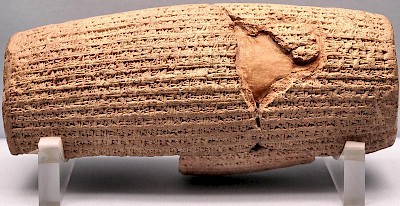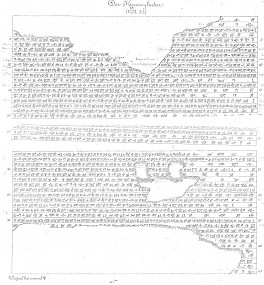Cyrus Cylinder
In the Cyrus Cylinder, a cuneiform tablet now in the British Museum, Cyrus describes how he had conquered Babylon (October 539 BCE). It is interesting because the Persian king presents himself to his new subjects as the perfect ruler, carefully copying Babylonian ideas about good governance. The Akkadian text can be found here.
Introduction

The Cyrus Cylinder, discovered in 1879 and now in the British Museum, is one of the most famous cuneiform texts, because it was once believed that it confirmed what the Bible says:note that in 539 BCE, the Persian conqueror Cyrus the Great had allowed the Jews to return from their Babylonian Captivity.
Although this information can in fact not be found in the text (it focuses on countries east of the Tigris), the Cyrus Cylinder remains an interesting document, because it shows that the common elements of Babylonian and Assyrian royal propaganda were also used by the Persian conqueror: for example the restoration of the temples, good care for the gods, the return of exiles and the statues of the deities,note and a lengthy titulary.note
The document is also interesting because it confirms information from the Nabonidus Chronicle: that, after the battle of Opis, the capture of Babylon itself was peaceful. Sources that indicate that Nabonidus, the last king of Babylonia, was impopular and believed to be mad, such as the Verse Account, are also corroborated by the Cyrus Cylinder.
Modern propaganda

The cylinder played an important role in the imperial propaganda of Shah Mohammad Reza Palavi, who in 1971 used it as symbol of the celebration of what he called the 2,500th anniversary of the Persian monarchy. A copy of the cylinder was given to the United Nations, from which all religious references where let out. The Shah tried to prove that the secular Iran with religious freedom that he wanted to promote had existed before, and in this context, the Cyrus Cylinder was called the "world's human rights charter". This interpretation ignores the stereotypical nature of the document.
However, the idea that the Cyrus Cylinder plays a role in the history of human rights, has turned out to be quite persistent, and because the text itself does not enable the interpretation, a fake translation has been made that can still be found on many places on the internet and was, for instance, quoted by Shirin Ebadi when she accepted the Nobel Peace Prize in 2003. The fake translation can be recognized because the name of the supreme god, Marduk, is replaced by Ahuramazda, and because it contains lines like
I announce that I will respect the traditions, customs and religions of the nations of my empire and never let any of my governors and subordinates look down on or insult them as long as I shall live. From now on, while Ahuramazda lets me rule, I will impose my monarchy on no nation. Each is free to accept it, and if any one of them rejects it, I shall never resolve on war to reign.
I do not know the author of the falsification, but because the fake text is usually published after the text known as fragment-A, I suspect that it was made before fragment-B was discovered.

The transcript of the text offered on this page has been adapted from the edition by Hanspeter Schaudig; the translation is based on Mordechai Cogan's, published in W.H. Hallo and K.L. Younger, The Context of Scripture. Vol. II: Monumental Inscriptions from the Biblical World (2003, Leiden and Boston), but has been adapted to Schaudig's edition with the help of Bert van der Spek.{{Thanks to Irving Finkel, Michael Kozuh, Matthijs Risselada, Hanspeter Schaudig, Bert van der Spek, Matthew Stolper.]
Description of the text
Fragment A:
The clay cylinder (BM 90920) is about 23 cm wide and 8 cm in diameter. It is inscribed on all sides and contains lines 1-35.
Fragment B:
There is a small fragment (8,6 cm wide, 5,6 cm high), containing lines 36-45, that can be joined to the main part. It used to be in the collection of the Yale University (NBC 2504) but is, together with main fragment, now in the British Museum.
Editions, literature
- P.-R. Berger, "Der Kyros-Zylinder mit dem Susatzfragment BIN II Nr.32 und die akkidischen Personennamen im Danielbuch" in: Zeitschrift für Assyriologie 65 (1975) 192-234
- J. Harmatta, "Les modèles littéraires de l' édit babylonien de Cyrus", in: Acta Iranica 1 (1974) 29-44
- Amélie Kuhrt, "The Cyrus Cylinder and Achaemenid Imperial Policy" in Journal for the Study of the Old Testament 25 (1983) 83-97
- H.C. Rawlinson, Th.G. Pinches, A Selection from the Miscellaneous Inscriptions of Assyria and Babylonia (1884, 1909 London), #35
- Hanspeter Schaudig, Die Inschriften Nabonids von Babylon und Kyros' des Großen (2001 Münster)
- R.J. van der Spek, "Did Cyrus the Great introduce a new policy towards subdued nations?" in: Persica 10 (1982) 278-283
- R.J. van der Spek, "Cyrus the Great, Exiles and Foreign Gods. A Comparison of Assyrian and Persian Policies on Subject Nations" in: W.F.M. Henkelman, C.E. Jones, M. Kozuh, C. Woods (eds.), Extraction and Control: Studies in Honor of Matthew W. Stolper (forthcoming)